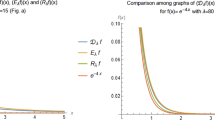Abstract
Because of the full covariance matrices and the computer storage limitations the number of measurements which can be handled by the collocation method simultaneously, is limited. This paper presents a method to compute covariance functions with a finite support yielding sparse covariance matrices. The theoretical background is pointed out and, for the one- and two-dimensional case, special functions are developed which can be combined with the usually used covariance functions to get a “finite covariance function”. Simulated examples to demonstrate the behaviour of different solution methods to solve these special, sparse covariance matrices supplement our investigations.
Similar content being viewed by others
References
I. BRONSTEIN: A Guide Book to Mathematics. Springer, New York, 1973.
R. HANSON. A Posteriori Error Propagation. Second International Symposium on Problem Related to the Redefinition of Northamerican Geodetic Networks; Proceedings, pp. 427–445, 1978.
P. MEISSL: A Priori Prediction of Roundoff Error Accumulation in the Solution of a Super-Large Geodetic Normal Equation System. NOAA Professional Paper 12, 1980.
P. MEISSL: The Use of Finite Elements in Physical Geodesy. OSU Rep. 313, 1981.
P. MEISSL: A Modern Approach to Least Squares Adjustment. Mitteilungen der Geodätischen Institut der TU Graz, Folge 43, 1982.
H. MORITZ: Covariance Functions in Least-Squares Collocation. OSU Rep. 240, 1976.
H. MORITZ: Advanced Physical Geodesy. Wichmann, Karlsruhe, 1980.
L. MUSSIO: Il metodo della collocazione minimi quadrati e le sue applicazioni per l'analisi statistica dei risultati delle compensazioni. Ricerche di Geodesia, Topografia e Fotogrammetria, 4, Clup, Milano, 1984.
A. PAPOULIS: Systems and Transforms with Applications in Optics. E. Krieger, Malabar, Florida, 1981.
F. SANSÒ: The Analysis of Time Series with Applications to Geodetic Control Problems. In “Optimization and Design of Geodetic Networks”, Springer, Berlin, 1985.
F. SANSÒ: Statistical Methods in Physical Geodesy. In “Mathematical and Numerical Techniques in Physical Geodesy”. Lecture Notes in Earth Sciences, Springer, Berlin, 1986.
W.-D. SCHUH: Analyse und Konvergenzbeschleunigung der Methode der Konjugierten Gradienten bei Geodätischen Netzen. Mitteilungen der Geodätischen Institute der TU Graz, Folge 49, 1984.
H. SÜNKEL: A General Surface Representation Module Designed for Geodesy. OSU Rep. 292, 1980.
H. SÜNKEL: Cardinal Interpolation. OSU Rep. 312, 1981.
H. SÜNKEL: Splines: their equivalence to collocation. OSU Rep. 357, 1984.
OSU Rep.: Reports of the Department of Geodetic Science and Surveying, Ohio State University, Columbus, Ohio.
Author information
Authors and Affiliations
Rights and permissions
About this article
Cite this article
Sansò, F., Schuh, W.D. Finite covariance functions. Bull. Geodesique 61, 331–347 (1987). https://doi.org/10.1007/BF02520559
Received:
Accepted:
Published:
Issue Date:
DOI: https://doi.org/10.1007/BF02520559




